- Failed to log in. Log in or create account
- My Profile Log out
-
Close
- Tournaments
Attention!
You are viewing a news item in the old website format. There may be display issues in some browser versions.
100 Years of Tanks: The British ”Devil” and Its Brothers
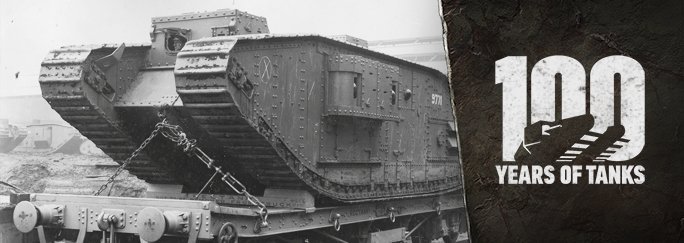
Hardly anyone could predict that many books on military theory would become outdated on 15 September, 1916, when the first tank saw combat. "The devil’s coming!” exclaimed a nameless German soldier, announcing that the new king of land warfare had arrived.
The French and Germans also developed their own tanks – however, the British rhombohedron-shaped designs remained the first among first. There were nine vehicle types in total. Some of them saw combat, while the other vehicles remained prototypes. The slides in this article will briefly tell the history of the rhomboidal tanks:
The Mark I: The Somme Mystery

September 15, 1916 — the first time tanks experienced real combat. It was a foggy morning on the frontlines of the Somme, and the German soldiers were horrified by the steel monsters appearing out of the morning haze. Hardly anyone recollects the other battles the Mark I tanks fought later. Nevertheless, they performed even better later in autumn 1916, compared to their debut battle.
On September 25 and 26, 13 Mark I tanks fought at Gueudecourt and Fesmy-le-Sart. Nine of them became stuck in shell craters. Two other vehicles reached their destination while supporting the infantry and got stuck there. Eventually, only a single Mark I Female tank equipped with machineguns remained on the move. The tank secured the German trench in less than an hour, and 370 German soldiers surrendered. In a different battle, three Mark I tanks attempted a frontal assault. One of them was destroyed by German artillery, while the rest of the vehicles became stuck. However, the tanks horrified the Germans so much that they laid down their arms.
It is fair to say that the tanks had a striking effect upon the German forces only a couple of weeks after the vehicles first saw combat. However, the brand-new vehicles had some significant construction drawbacks which harmed their reputation among the British themselves.
The Mark II and Mark III: Limited Edition Evolution

Britain built a hundred Mark II and Mark III tanks in total, which is 75 vehicles less than the number of Mark I tanks produced. Thus, in historical literature, they are often called limited edition vehicles of the transition period. Nevertheless, some unique features were implemented to the Mark II and Mark III tanks.
For example, the Mark II did not have the famous steering tail intended for overcoming trenches. According to legend, one tank lost its steering tail in battle – however, the tank remained on the move which meant that the wheel contraption was useless. Engineers were thus able to decrease the tank's length by two meters without harming the vehicle's crossing capacity! They equipped the vehicle with a tool box instead (for spare parts and tools). The exhaust stacks were also moved to the tank's rear.
As for the Mark III, the engineers intended to increase the vehicle's frontal armour by using armoured screens. Though the engineers made a lot of holes for mounting these additional screens, they eventually decided against it – they implemented a special contraption for self-extraction instead: a thick wooden balk mounted on the roof, which was to be used as a support beam when pulling out a stuck vehicle. This feature was found to be rather useful, and was applied to all similar vehicles.
The Mark IV: The First Millenium Vehicle

The Mark IV was a mass produced modification of the rhomboidal tank, with over a thousand vehicles being built in total.
The order to construct the Mark IV was issued in September 1916, right after the first rhomboidal tanks saw combat at the Somme. The new Mark IV tank had significant new features in comparison with the Mark I.
First of all, the new tank featured improved armour – thus rifle and machinegun fire could not damage it anymore. Since the vehicle had a bevel-edged shape the side turrets did not touch the terrain when rolling. They were equipped with special rails, so it was not necessary to dismantle them before transporting the tanks by rail – they were simply hidden inside the hull. Unfortunately, the new construction was rather vulnerable: sometimes, the tanks broke during battle, and the side turrets rolled inside the hull making a lot of loud noise. The fuel tanks were located in the vehicle's rear in order to reduce the chance of being ignited.
By May 1917, the Mark IV tanks arrived in France and were adopted by the British army. The new tank proved itself in combat, the armoured giants easily breaching wire entanglements and providing supporting fire, allowing the infantry to advance. In November 1917, one of the vehicles demonstrated its power in a very specific way: it broke through a 1.5 meter high fence, moved across a fruit garden, knocking down trees, and damaged a building corner when making a turn.
The new vehicles only had a range of 56 kilometres – however, it was a significant step forward in comparison to the Mark I.
The Mark V and the First “Real” Tank Engine

By the end of 1917, the development of the new rhomboidal vehicles was discontinued. Armourers were afraid that rifles, machineguns, and cannons would become useless because of tanks, and they interfered with the tank developers and producers. However, they were unable to stop the development of armoured vehicles. The Mark V rhomboidal tank entered mass production in December 1917.
Combat proved that the vehicle required a more powerful engine that could withstand different service conditions, and could be more easily repaired on the frontlines. In addition, the engineers could not use alloy steel or aluminium when developing the engine since these materials were used by the aviators. Harry Ricardo was the first engineer to develop the first real tank engine. His engine satisfied the military's requirements. Wilson implemented the new transmission to the engine, which simplified the vehicle's controls.
The Mark V also featured an aerial telegraph that replaced the signal flags. The British army received 400 Mark V tanks – two hundred “male” vehicles, equipped with guns; and two hundred “female” vehicles, equipped with machineguns – from May 1918 through to the end of the First World War.
The first tank duel occurred on April 24, 1918 between the Mark IV and the A7V German tank. The encounter proved that tanks equipped with machineguns were effective against infantry only. As a result, some machineguns in one of the side turrets were replaced with guns. Such asymmetric tanks were jokingly calledHermaphrodites.
The Battle of Passchendaele: A Muddy Affair

Early in the morning on 31 July, 1917, the British army attempted an assault at the Ypres River in the direction of the Belgian town of Passchendaele.
Moving through swamps and small woods, the tanks would require corduroy roads to move. Since the drainage facilities were destroyed by artillery fire, the roads would not be of any use either. Tank officers warned that the vehicles would not be able to overcome the muddy fields, especially since weather conditions were poor and it was raining heavily. Unfortunately, no one ever thought of giving up the armoured assault.
The tanks halted by mid-afternoon. Many of them got stuck in the water and could not get out. At the same time, the Germans were mounting an effective defence, their artillery constantly firing at the impeded tanks. The infantry that followed the Mark IVs and Mark Vs also became bogged down in the mud. The German forces also brought their peculiar Fahrpanzers mobile turret emplacements to the battlefield to target British troops. German aircraft circled over the battlefield at low altitude trying to damage the British tanks, while one daring tank commander dismounted a machinegun in a desperate attempt to return fire.
The British assault had failed. The tanks that survived the battle would be in a state of repair behind the lines until August 1917.
The Battle of Cambrai: Another Attempt
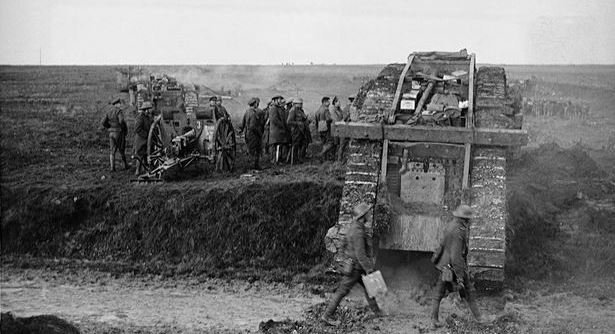
In the summer of 1917, officers of the Royal Tank Corp came up with an idea for the perfect armoured assault. According to the plan, the tanks were to attack when conditions were excellent, so they could perform at their best and achieve a convincing victory. In addition, it was hoped this would improve their tarnished reputation. Cambrai, situated in the north-east of France, seemed to be the perfect area for such an assault – the war had not come there yet, and the terrain was still dry and solid.
The Mark IV tanks were to break through the German Hindenburg defence line. Originally, a local tank raid was planned – however, it was later expanded into a comprehensive military operation.
The tanks were secretly moved to the 3rd Army under the command of lieutenant-general Sir Julian Byng, with machine guns firing to disguise the roaring of the engines. The vehicles required over a million litres of gasoline and oil, and over half a million shells.
The assault began on 20 November, 1917, with Royal Tank Corp commander Hugh Elles personally leading around 350 tanks into battle in his command vehicle. The tanks easily broke through the wire entanglements, crossing several miles into enemy territory, while hundreds of German soldiers surrendered. However, things were soon to go downhill.
The infantry—highlanders of the 51st division—were engaged in combat at the nearby village of Flesquières, located at the edge of a steep hill. While the highlanders were falling back behind the tanks, the Germans deployed their military reserves over the hill and delivered a hail of bullets. The Mark IV tanks were caught climbing the hill, allowing the German forces to shoot at their vulnerable undersides, which could be penetrated by machine gun fire. The British assault force failed to enter Cambrai, and ten days later, the Germans counter-attacked, regained the previously lost territory and then some.
Tanks during the Hundred Days Offensive
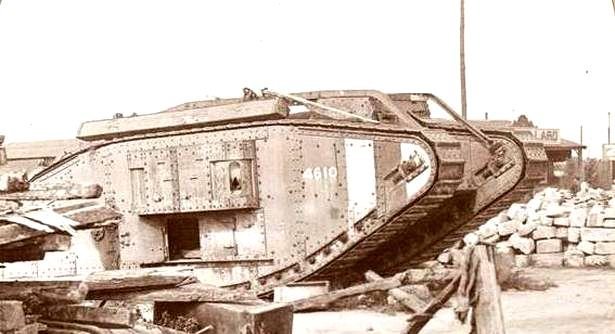
The Hundred Days Offensive was the final period of the First World War. During the offensive, the Allies launched a series of assaults on the Western Front. It started at Amiens and lasted from August through to November 1918. At Amiens, the Allies attempted to regain one of the important French railway lines. It was the largest military operation during the First World War that tanks participated in.
The entire Royal Tank Corps were deployed on the frontline. The brand-new Mk. A Whippet medium tanks participated in the offensive together with 324 Mark V tanks. On August 8, 1918, the tanks moved forward. Though the tanks were unable to communicate with the infantry effectively (some commanders were following their tanks on horseback in order to coordinate the combat), there were more than 23 Marks per kilometre of frontline, which compensated for the communication drawbacks.
Supported by artillery fire, the tanks were breaking through the German defences. Mist and smoke covered the German trenches, preventing their anti-tank artillery from firing. Occasionally, the British tankers would leave their vehicles and gesture to their enemies to surrender for good. The German artillery used shells with tear gas in an attempt to prevent the infantry and artillery from moving together with the tanks. Nevertheless, the gas did not have a significant effect.
Many of the British vehicles were damaged during the first day of the offensive – most of them being damaged by enemy fire, with only a small minority breaking down on their own. Nevertheless, the Germans had failed to defend their positions. The Hundred Days Offensive ended with the Armistice of 11 November 1918, with the capitulation of Germany.
The Mark VIII: The Anglo-American
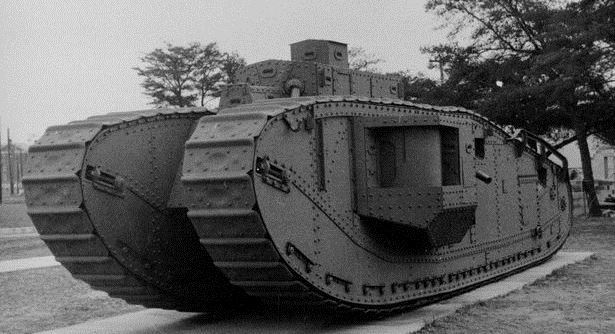
The Mark II and Mark VI remained prototypes and never saw large-scale production. The Americans decided to participate in developing the next rhomboidal vehicle. During the First World War, they fought for the Allies and were fascinated with tanks. First, they ordered 600 Mark VI tanks for the army. Next, they changed their mind, cancelled the order, and suggested developing a new rhomboidal tank together with British engineers. The Mark VIII newer saw combat during the First World War, as only five vehicles were built by the war's end. After the war, the production of the Mark VIII tanks was moved to the USA.
As for the vehicle's appearance, it featured a different suspension compared to the other rhomboidal tanks. The tracks were still arranged in a rhomboidal form around the hull – however, the hull was stretched, and the tank resembled a teardrop rather than a rhomboid. The Mark VIII featured a 338 HP Liberty engine in the rear, which was separated from the crew by a wall, allowing the crew to breathe more easily. The engineers did not divide the vehicles into “males” and “females” – instead, they mounted a 57 mm gun in each of the vehicle's side turrets, while the machine guns were mounted in the roof turret. In addition, it was possible to mount machine guns in socket mounts in the vehicle's side doors.
The Mark VIII (designated Liberty) was the only heavy tank the United States had until 1930. It underwent some trials but never saw combat. When the Second World War started, the USA sold 90 vehicles to the Canadian Army for the purpose of training.
The Mark IX: A Troop-Carrying Vehicle
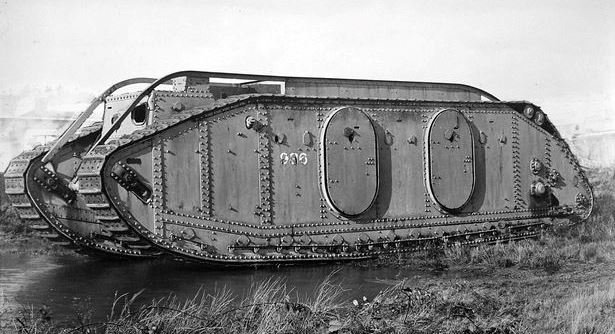
The first tanks could hardly coordinate their actions with the infantry. It was not just about the fact that the soldiers were not used to fighting together with armoured vehicles – the point was that the tankers were sitting inside vehicles protected with armour, while the infantrymen were vulnerable to bullets and fragments.
Eventually, military engineers developed a troop-carrying rhomboidal tank. All the side turrets were removed, and the only machineguns remained at the vehicle's front and rear. This cleared some space in the tank, allowing up to 30 soldiers, or 10 tons of cargo, to be transported while protected by 10–12 mm of armour. The Mark IX tank was also equipped with a fan and a tank for storing drinking water – alas, these amenities were located near a hot engine, which undermined them.
A couple of these vehicles were produced by the end of the First World War. One of them was used as an armoured ambulance on the Western Front in 1918, with soldiers named this weird vehicle The Pig.
Sources:
- Fedoseyev S. L. Tanki Pervoy mirovoy. M., 2012.
- Glanfield J. The Devil’s Chariots. Osprey, 2013.
- Stern A. G. Tanks 1914–1918. The Log-Book of a Pioneer. London, 1919.
- Swinton D. E. Eyewitness. Being Personal Reminiscences of Certain Phases of the Great War, Including the Genesis of the Tank. New York, 1933.
This product is not licensed, endorsed, and/or affiliated with any branch of federal, state, and/or sovereign government, or any military branch or service thereof, throughout the world. All trademarks and trademark rights pertaining to military vehicles are proprietary to the respective rights holders. Reference to a particular make, model, manufacturer, and/or version of any military vehicle is for historical accuracy only, and does not indicate any sponsorship or endorsement of any trademark owner whatsoever. Characteristics of all models are realistically reproduced on the basis of technical elements of military vehicles from the 20th century. All trademarks and trademark rights pertaining to military vehicles are proprietary to the respective rights holders.
© 2009–2025 Wargaming.net All rights reserved.






